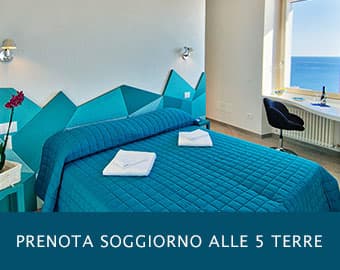Recommended
by CinqueTerre.com
 The only natural port of the Cinque Terre, the village of Vernazza develops along the Vernazzola stream (now covered), to go up again on the slopes of a rocky spur that hides the village from those coming from the sea. Steep and very narrow paths lead down to the main road that leads to a small square located in front of the marina. To the same typology of the tower houses, also present in Riomaggiore, Manarola and Monterosso, are added more elaborate and refined architectural forms such as decorated portals and arcades, evidence of the prosperity enjoyed by the town during the Genoese domination. The structures of the castle are very well preserved, a characteristic note of the Cinque Terre and of Vernazza in particular.
The only natural port of the Cinque Terre, the village of Vernazza develops along the Vernazzola stream (now covered), to go up again on the slopes of a rocky spur that hides the village from those coming from the sea. Steep and very narrow paths lead down to the main road that leads to a small square located in front of the marina. To the same typology of the tower houses, also present in Riomaggiore, Manarola and Monterosso, are added more elaborate and refined architectural forms such as decorated portals and arcades, evidence of the prosperity enjoyed by the town during the Genoese domination. The structures of the castle are very well preserved, a characteristic note of the Cinque Terre and of Vernazza in particular.
 The marina can accommodate small-medium boats and is a valid shelter for medium-intensity waves, while it is not sufficient for large winter storms. Vernazza has been for years the main attraction in the Cinque Terre, together with Monterosso. The glance is undoubtedly the most spectacular either by coming by sea or by the paths. The inhabited center has its fulcrum in the piazza on the sea, right next to the small harbor and therefore, especially in moments of greater tourist influx, the overcrowding can be a bit annoying, especially for those who intend to stay there. To find some peace, above the village of Vernazza, there is the sanctuary of Nostra Signora di Reggio, which can also be reached on foot via the path known as the Strada dei Santuari.
The marina can accommodate small-medium boats and is a valid shelter for medium-intensity waves, while it is not sufficient for large winter storms. Vernazza has been for years the main attraction in the Cinque Terre, together with Monterosso. The glance is undoubtedly the most spectacular either by coming by sea or by the paths. The inhabited center has its fulcrum in the piazza on the sea, right next to the small harbor and therefore, especially in moments of greater tourist influx, the overcrowding can be a bit annoying, especially for those who intend to stay there. To find some peace, above the village of Vernazza, there is the sanctuary of Nostra Signora di Reggio, which can also be reached on foot via the path known as the Strada dei Santuari.
Vernazza: what to see
 The origin of Vernazza is ancient and derives from its role as the only natural small port in this coast: the first historical news dates back to 1080, when in a document, it is named "the castrum Vernatio", the castle of Vernazza, as a maritime base of Obertenghi, lords of Vernazza, who built the first defensive system of the village. The symbol of the castle and of the town is the tower that stands at about 70 meters above the sea at the end of the town. This cylindrical tower is, in fact, the oldest part, while the rest of the castle has a very irregular layout as, during its construction, it was adapted to the rocky spur into which it is incorporated. The castle, which today is a cultural center, kept inside a bronze cannon bearing the engraved inscription "Comunitas Vernatiæ", but it was taken away by English soldiers and is now exhibited at the British Museum in London. Immediately below the castle is the Belforte, a quadrangular bastion built above the rocks at the beginning of the marina. Of difficult historical date, it probably dates back to the phase of the Genoese domination.
The origin of Vernazza is ancient and derives from its role as the only natural small port in this coast: the first historical news dates back to 1080, when in a document, it is named "the castrum Vernatio", the castle of Vernazza, as a maritime base of Obertenghi, lords of Vernazza, who built the first defensive system of the village. The symbol of the castle and of the town is the tower that stands at about 70 meters above the sea at the end of the town. This cylindrical tower is, in fact, the oldest part, while the rest of the castle has a very irregular layout as, during its construction, it was adapted to the rocky spur into which it is incorporated. The castle, which today is a cultural center, kept inside a bronze cannon bearing the engraved inscription "Comunitas Vernatiæ", but it was taken away by English soldiers and is now exhibited at the British Museum in London. Immediately below the castle is the Belforte, a quadrangular bastion built above the rocks at the beginning of the marina. Of difficult historical date, it probably dates back to the phase of the Genoese domination.
 The centerpiece of the village is the beautiful Church of Santa Margherita d'Antiochia, whose original core in Romanesque style dates back to the 12th century by the Magistri Antelami on a previous religious building. Subsequent alterations expanded it and dressed it in the Baroque style and then restored to its original, simple and more austere style, dominated by the dark sandstone and the Mesco stone and sometimes the wooden roof. Wonderfully overlooking the cliff, the church is the object of a legend: in a past unspecified time, a wooden box with the bones of a Santa Margherita finger was found on the beach. The population shouted a miracle and decided to found a church dedicated to her in another place in the country. But a wave made the relic disappear, which reappeared some time later on the beach where it had been found the first time. The Vernazzesi understood then that they had to build the church there and so they did.
The centerpiece of the village is the beautiful Church of Santa Margherita d'Antiochia, whose original core in Romanesque style dates back to the 12th century by the Magistri Antelami on a previous religious building. Subsequent alterations expanded it and dressed it in the Baroque style and then restored to its original, simple and more austere style, dominated by the dark sandstone and the Mesco stone and sometimes the wooden roof. Wonderfully overlooking the cliff, the church is the object of a legend: in a past unspecified time, a wooden box with the bones of a Santa Margherita finger was found on the beach. The population shouted a miracle and decided to found a church dedicated to her in another place in the country. But a wave made the relic disappear, which reappeared some time later on the beach where it had been found the first time. The Vernazzesi understood then that they had to build the church there and so they did.
Vernazza beaches: in Vernazza there is a small sandy beach below the central square, a slightly larger one that can be reached by crossing the cave along the main street, Via Roma. The rocks are then used below the church and in some parts of the marina.
Useful Information
How to reach Vernazza:
- By train: it is advisable to use the train via the special Cinque Terre Express services that Trenitalia provides about every 10 minutes in spring-summer. Vernazza stop.
- By car: from the center of La Spezia, after the A.Picco stadium take the SP 370 and after Manarola continue with the SP 51. At San Bernardino turn right. The road is downhill with many curves, narrow and winding and the parking lots are meager.
- Sea connections: ferries available every spring and summer departing from La Spezia, Lerici and Porto Venere, Monterosso, Manarola and Riomaggiore. For more information and timetables: www.navigazionegolfodeipoeti.it
Info Point Reception and Tourist Information: located at the railway station, Tel. 0187/812533, mail: accoglienzavernazza@gmail.com





